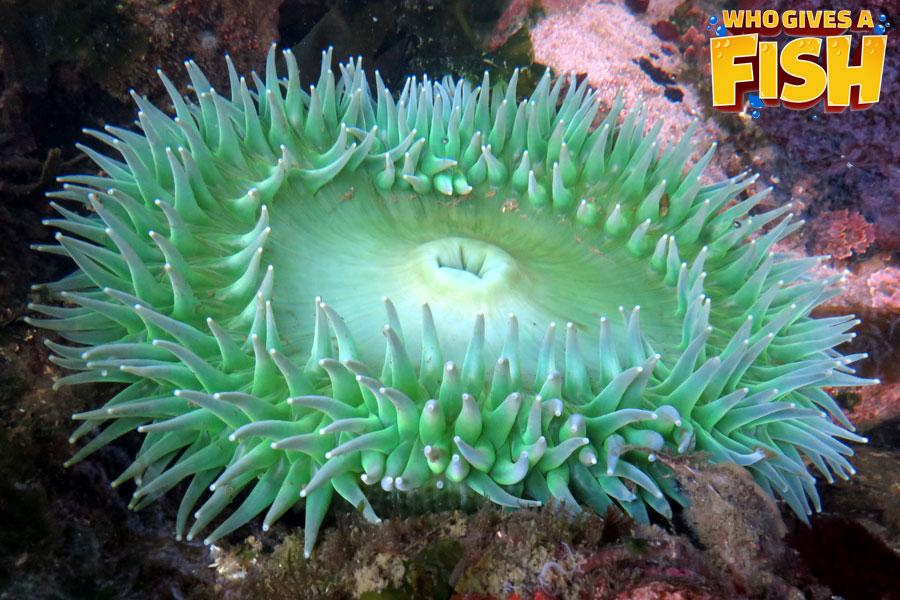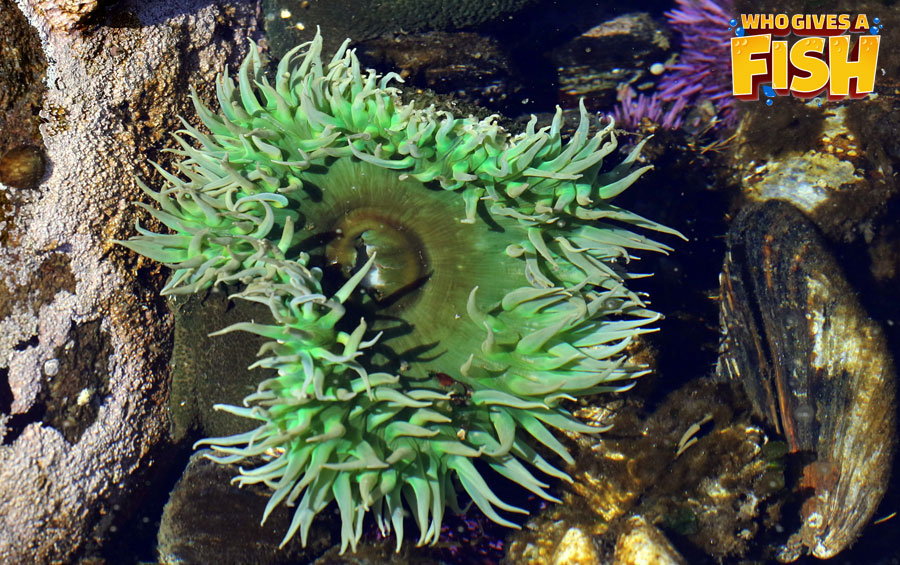Giant Green Anemone
The Giant Green Anemone, Anthopleura xanthogrammica, is rated by hobbyists as being one of the most stunning and attractive of all anemones. They can grow to be very large, up to around 11” (30cm) tall and up to 6.5” (17cm) wide. They have a very strong green color and often resemble that of a flower or plant but are in fact an animal.
These beautiful anemones are like others as they form strong symbiotic relationships with marine algae found in its tissues, called zooxanthellae. This algae provides nourishment for the anemones when provided with the right lighting.
- Experience Level: Advanced/Expert
- Hardiness: Very difficult to keep in captivity
- Minimum Tank Size: 100 gal (380 L)
- Lighting Needs: Strong, direct light
- Temperature: 60° – 72° F (15.5° – 22.2° C)
- Gravity: 1.023 – 1.025
Table of Contents
Introduction
Aquarium Setup
Difficulty
Feeding
Breeding
Social
Under strong lights, the algae are able to grow and subsequently provide the anemones with its strong green coloring. When these anemones live in more shaded areas, the algae’s growth is limited which doesn’t allow the strong green coloring, creating a white color in extreme cases.
These anemones will be found along the Pacific coast line amongst the shoals. They enjoy living in areas that are mid-low intertidal zones where there is a strong wave presence. They will be found living in the crevices of rocks or even under them or on the side. Because of this they are also known as the Green Surf Anemone or the Giant Green Pacific Sea Anemone.
If Giant Green Anemones are left completely out of the water during the tidal recession, they will force the water out of their body cavities, pull their tentacles in and fold inward to protect themselves until the tide returns. During this period, they do not look so nice, and will resemble blobs or muddy looking donuts instead of a bright green anemone. It is very important that people leave them alone when they are found like this and when underwater. These anemones require cold water to survive unlike the warm tropical aquariums held by marine enthusiasts. They are also banned from being collected in many areas.
They have been seen to grow up to around 11” (30cm) tall and up to 6.5” (17cm) wide, with their life span currently unknown. Some anemones have been reported to live hundreds of years in the wild, with some in captivity apparently been recorded over 80 years.
The Giant Green Anemone is a very pretty coral, with its pedal column being a brown to olive green color that is topped with tentacles that are bluish, greenish and sometimes even white with no other markings. Their oral disc will generally be a blue, brown, gray or green color.
These beautiful anemones form symbiotic relationship with zooxanthellae, a marine algae that lives within their tissues and is responsible for nourishing the anemone and providing it with its green coloring. This green coloring will be dulled when the anemones are found in more shaded spots.
Their bodies are soft and squishy that are flat when open. Their base will have a foot that is very sticky and will adhere to many different surface types. This foot will also be used to move the anemone around when conditions or not favorable. Their tentacles are short and thick that taper at the ends, being placed in 6 or more rows along the oral discs surface margin, and their mouth being in the center. The Anthopleura genus will use the same opening to intake food as it does to expel waste. This mouth should be closed tight at all times unless feeding where it will have an oval look to it. A gaping mouth is a sure sign of ill health.
Aquarium Setup
Giant Green Anemones are able to be kept in nano reefs of just 20 gallons if desired with a typical reef environment being required but it has to be a cold reef, and given their size potential, this is highly advised for long term. They need to be placed on some live rock or another form of solid material that they can attached their foot to. Because calcium levels are not required at high levels in a cold-water tank, reef rock isn’t actually necessary.
Bacterial formations take a lot longer to develop in cold water, so the most important thing for a nano reef is adequate chemical and mechanical filtration. Ensure the use of a good skimmer and place filter floss and some chemical additives like GFO and Chemi-pure. Carbon can also be used to help clean the water. Chemi-pure is a good way of removing nitrogenous waste, ammonia, phenol, copper and other heavy metals. It will also aid in keeping the pH at a consistently safe level. GFO (Granular ferric oxide) will help control phosphates in the system. A refugium with a deep sand bed can also help maintain healthy conditions.
These Anemones require some moderate water flows and some strong lighting. Light from LEDs and t5 units will put out less heat which is essential when keeping a cold-water tank. It is recommended to maintain temperatures between 55 to 60°F (12.7 – 15.5°C). This will allow for both sub-tidal animals and inter-tidal animals to be kept in your tank. You should also have a chiller but keep the temperatures stable as fluctuations will stress your anemone. Acrylic tanks are good for preventing temperature fluctuations, with each ½ inch providing a 5° F thermal barrier. Ensure to cover all of your pumps, the majority of good pumps should come with them.
Giant Green Anemone Aquarium and Parameter Checklist
- Minimum Tank Size: 100 gal (300 L), however, can raise small specimens in nano tanks.
- Lighting Needs: Strong, direct light
- Temperature: 60° – 72° F (15.5° – 22.2° C)
- Specific gravity: 1.023 – 1.025
- Alkalinity Levels: 7 – 11 dKH
- Calcium: 380 – 450 ppm
- Magnesium Levels: 1250 – 1350
- Strontium Levels: 5 – 15 ppm (8-9 is optimal)
- Water Movement: Low – Moderate
- Tank Region: Bottom
Difficulty
These anemones are very rarely available for purchase through retailers and are very often banned from being collected. Specimens in the Anthopleura genus are known to be difficult to care for and should be left in the wild. If they do become available for purchase somehow, they should only be kept by more experienced hobbyists. They need to be housed in tanks with cold water and good lighting and an aquarium that is at least 6 months old.
When choosing any anemone from the Anthopleura genus, ensure that it is in good health before taking it home. Make sure it has a good color to it, in this case plenty of green. Ensure its foot is stuck to something and its not bouncing around the tank. Its foot and its tentacles should be sticky to the touch and the foot not showing any damage from being pulled of the rocks.
If you need to move an Anthopleura between aquariums, use a blunt, thin object to get under its foot. A credit card is a popular choice, as well as shallow plastic spoons. Slowly move the blunt object under the anemones foot, encouraging it to release from the surface. If it is stuck to a rock, purchase this entire rock to place in your tank.
Feeding
The Giant Green Anemone is carnivorous, feeding primarily on dislodged mussels, crabs, small fish and sea urchins. There have been pictures of these eating Ochre Starfish. When in captivity, these anemones can be fed frozen carnivore preparations, freshly chopped fish from your grocery store, mussels, krill, shrimp and chopped silverside.
The Anthopleura species has a slower metabolism than that of warm water anemones, as they are cold water animals they should only need feeding once or twice each month.
Breeding
The Giant Green Anemone has not been bred in captivity but should divide. There is currently no information on propagating cold water anemones, but it is possibly similar to other anemones species. Other cold-water anemones will use external fertilization of eggs and sperm or through fission.
Cold water anemones are known to use the external fertilization of eggs and sperm to reproduce. Mature gametes will be shed into the coelenteron which is their digestive cavity. These are then spawned through its mouth. Two gametes being fused will create a zygote which develops into a planktonic planula larva. These larva will eventually float away and begin a process of early morphogenesis of tentacles, pharynx and septa. Once they eventually find a spot to land e.g. well-established mussel beds, a pedal disk will form and eventually grow a whole new anemone.




Social
These anemones are rated as being semi-aggressive due to their mobile behavior and could even split in your aquarium. It is recommended to not house these anemones as they can move so often and kill corals and fish as they do so. If their needs are met most anemones will stay put, but this can be hard to get right straight away.
Once they have split they will generally tolerate their new “twin” and often members of their own species. Each anemone in your tank should be provided with its own space, otherwise a chemical war can start between species. This will see anemones shrinking, unable to feed and eventually dying.
Because of their mobile behavior, they should be kept in a species-specific type display. They should be placed in your aquarium first and allowed plenty of time to settle and get comfortable, before adding other corals.
Back to top